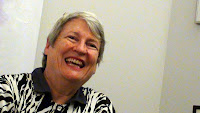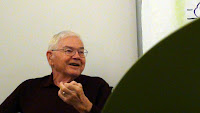 The VIAVOX in Seattle last month was a hit, thanks to a relevant topic and a great group of panelists!
The VIAVOX in Seattle last month was a hit, thanks to a relevant topic and a great group of panelists!First, to explain the broader picture: our firm has historically hosted “Salons,” which aim to initiate conversations surrounding current issues in architecture, planning, and design. We recently renamed these to be called VIAVOX. Latin for ‘voice,’ we intend to hold a quarterly VIAVOX in both our Seattle and Vancouver offices.
The VIAVOX in October addressed “Connected Senior Urbanism.” It was a discussion about how urban design can contribute to an engaged lifestyle as we age.
The inspiration for this includes:
- Naturally Occurring Retirement Communities (NORC’s). Here is a link to the local initiative
- Urban Planning for Seniors. Here is a link to EDRA
- Silver Seniors, an initiative in New York City. See this article
- Universal Design in the Public Realm
The following is a synopsis of what the panelists brought to the conversation:
Joanne Donohue, Senior Services
Aging Your Way
Supporting community members as they age, Aging Your Way is an attempt to start a different type of conversation around aging, focused on the positive aspects in lieu of the deficit side of aging. Through the parent organization, Senior Services, they get to see the strengths and relationships and lifetime of knowledge of the seniors and wanted to get other people excited about it. Wanting to maintain the good work seniors centers are doing, they also wanted to be relevant to seniors so they put together the Aging Your Way initiative.
Aging Your Way has hosted gatherings in several Seattle neighborhoods and plans more in the region and for selected population groups. Designed as a three hour gathering that starts with visioning and comes up with ideas to help get to that vision, they use open space facilitation to get to the ideas that shape the most energy in the room. During the two months prior to meeting with the community, they identify who the stakeholders and leaders are in a particular community and get them engaged.
There have already been four gatherings and there are four to six more planned in the next year, which will be topped off by a summit. Joanne pinned up large sketches documenting the input from previous gatherings and these elicited some lively conversation.
 Pam Piering, City of Seattle, Aging and Disability Services
Pam Piering, City of Seattle, Aging and Disability Services Pam introduced the notion that as adults age, they don't want just to be greeted: they want a living, breathing connection to a community, and they want to be a lively part of that.
Built environment + The quiet crisis
Seniors are flying below the radar in terms of their level of need right now. Addressing the built environment is essential and vehicles such as development incentives and the introduction of universal design are critical components.
Promotion of physical activity is a key ingredient. Research is powerful that says that, in addition to the social element of being outdoors, physical activity helps one live longer and provides connectivity to a neighborhood. Senior housing no longer necessarily means one big building with all of the units in one building: It can be integrated into the community and neighborhood, supporting a livable and walkable community. Many boomers and seniors are finding the “leisure worlds” created as retirement communities are not something they want, so addressing the built environment is essential. In many instances this means retrofitting design rather than building new.
Pam posed the question: How can we help residents stay healthy in their own homes?
Through initiatives like “Farm to Table,” local farmers are connecting with the tables where seniors eat. By getting fresh local fruits and veggies, we can impact the long term health of our communities.
Other key aspects include:
- Financial literacy and training.
- Retirement funds: more conversations and more support
- Health care reform is happening and talks about healthy communities and better information
- Public policies to help seniors stay in their homes
- Helping seniors have affordable housing with services available to them
- Support for seniors living with family members
- Locating housing where people can connect to public transit
- Encouraging people to look at successful models for seniors.
- The old models may not be the model of the future; it may be much more flexible.
- People are going to live longer, and injuries don't mean they'll stay in a care facility.
- There is a resiliency to seniors and we have to think of that in our new housing models.
- Advocacy strategies. How can we support better housing options for older adults?
- If you don't frame this in the right language, our policy world is too willing to let things slide along and not address it until it's too far along
Pamela “Tommy” Tomlinson
Legacy House
Tommy was not able to join us but the link above provides some insight to the Seattle Chinatown / International District Preservation and Development Authority and Legacy House. In addition to providing affordable assisted living to Seattle’s Asian community, Tommy has been instrumental in establishing various senior services including adult day health care and a lunch program. Her efforts are an example of putting into practice many of the concepts discussed by Pam.
Art Mussman
Art is active in volunteer activities where his special interests are affordable housing, transportation and access to medical services. Art serves on the Aging and Disability Services Advisory Council, Evergreen Hospital Community Advisory Council and the St. Jude - Redmond Stewardship Council. He also serves on the Kirkland Senior Council where he is active in promoting the use of Universal Design in the built environment. He focused on Universal Design as a way to facilitate the ability to age in community.
It's not just about taking all homes and making them livable for a person in a wheelchair. It's for everyone. For instance, round doorknobs are tough; people with arthritic wrists may have a hard time turning them. The same is true with light switches. There is no reason why not to lower the light switch. This allows a child to reach it as well as a person in a wheelchair. Meanwhile, the average person still has no trouble turning it on
Universal design applies to the community as well. Art used the example of the Kirkland Senior Center and the bus stop with no bus shelter. He also mentioned how even the stop is now gone making access to seniors that much more difficult!
The following link is to the Northwest Universal Design Council’s website, an organization Art is active in.
Aside from the discussion that grew from our panelists remarks, the group also talked about the concept of incentive zoning targeted towards affordable housing. The notion of accessory dwelling units has opened up a little in Seattle and may provide a model for other communities. We discussed the concept of the Fab Cab, a universally-designed pre-fabricated dwelling unit that has direct application as an accessory dwelling unit.
We enjoyed the conversation and believe it helped expand the dialog about the changing face of aging and the role of service providers, the community and design in that process.We look forward to continuing to host these events in Vancouver and Seattle!


